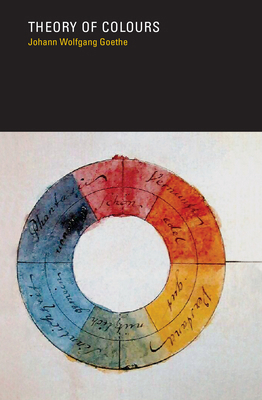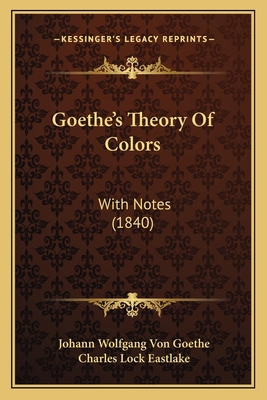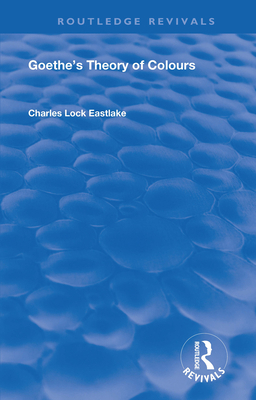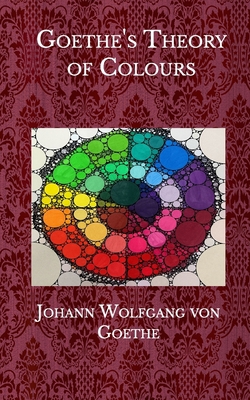All Formats & Editions

Theory of Colours (Mit Press)
![Zur Farbenlehre [German] 1499556314 Book Cover](https://i.thriftbooks.com/api/imagehandler/l/D8A72478318AA2837F8BE599F5396D24DCF98074.jpeg)
Zur Farbenlehre [German]

Theory of Colours
By closely following Goethe's explanations of the color phenomena, the reader may become so divorced from the wavelength theory--Goethe never even mentions it--that he may begin to think about color theory relatively unhampered by prejudice, ancient or modern. By the...

Theory of Colours:

Goethe's Theory of Colours (Illustrated Edition)
![Teoría de Los Colores: Las Láminas Comentadas [Spanish] 8425232503 Book Cover](https://i.thriftbooks.com/api/imagehandler/l/D81D1CD08D30F50C383E7BCE78DFCC9C270DD966.jpeg)
Teoría de Los Colores: Las Láminas Comentadas [Spanish]
Goethe lleg al color desde el arte. Su inquietud por los efectos crom ticos como recurso art stico lo llev a indagar incansablemente en el enigma del color y culmin en la elaboraci n de uno de los tratados cient ficos m s importantes de la teor a del color que rebat...

Goethe's Theory of Colours
This work has been selected by scholars as being culturally important, and is part of the knowledge base of civilization as we know it. This work is in the "public domain in the United States of America, and possibly other nations. Within the United States, you may freely...

Goethe's Theory Of Colors: With Notes (1840)
Goethe's Theory of Colors: With Notes (1840) is a book written by the famous German writer and philosopher Johann Wolfgang von Goethe. In this book, Goethe explores the nature of color and light, and presents his theory of how colors are perceived by the human eye. Goethe's theory...

Goethe's Theory of Colours: Translated from the...

Goethe's Theory Of Colors: With Notes (1840)
Goethe's Theory of Colors is a book written by the famous German writer and philosopher Johann Wolfgang von Goethe in 1840. The book is a comprehensive exploration of the nature of colors and their effects on human perception. Goethe's theory of colors is unique in that it is...

Goethe's Theory of Colours
The book "" Goethe's Theory of Colours "" has been considered important throughout the human history, and so that this work is never forgotten we have made efforts in its preservation by republishing this book in a modern format for present and future generations. This whole...
![Zur Farbenlehre [German] 3843090289 Book Cover](https://m.media-amazon.com/images/I/51nuCXKi2RL._SL500_.jpg)
Zur Farbenlehre [German]
Johann Wolfgang Goethe: Zur Farbenlehre Anzeige und bersicht des Goethischen Werkes zur Farbenlehre: Selbstanzeige. Erstdruck in: Morgenblatt f r gebildete St nde, 6. Juni 1810 Zur Farbenlehre. Didaktischer Teil: Erstdruck in: Zur Farbenlehre, 1. Bd., Stuttgart 1808. Materialien...

Goethe's Theory of Colours
This work has been selected by scholars as being culturally important and is part of the knowledge base of civilization as we know it. This work is in the public domain in the United States of America, and possibly other nations. Within the United States, you may freely...

Goethe's Theory of Colours
First published in German in 1810, this detailed volume was translated from the German by Charles Lock Eastlake and, in six parts, examines every aspect of Goethe's theory of colours, including psychological colours, chemical colours, the moral effect of colour, minerals,...

Goethe's Theory of Colours
This work has been selected by scholars as being culturally important, and is part of the knowledge base of civilization as we know it. This work is in the "public domain in the United States of America, and possibly other nations. Within the United States, you may freely...

Goethe's Theory of Colours, Tr. With Notes by C...

Theory of Colours
![Zur Farbenlehre. [German] 0341576220 Book Cover](https://i.thriftbooks.com/api/imagehandler/l/BFFA21B715BB4C61147E2B8BFE48ADEE193C0018.jpeg)
Zur Farbenlehre. [German]

Goethe's Theory of Colours
The desire of knowledge is first stimulated in us when remarkable phenomena attract our attention. In order that this attention be continued, it is necessary that we should feel some interest in exercising it, and thus by degrees we become better acquainted with the object of...

Goethe's Theory of Colours: Large Print
The desire of knowledge is first stimulated in us when remarkable phenomena attract our attention. In order that this attention be continued, it is necessary that we should feel some interest in exercising it, and thus by degrees we become better acquainted with the object of...

Goethe's Theory of Colours: Original Text
The desire of knowledge is first stimulated in us when remarkable phenomena attract our attention. In order that this attention be continued, it is necessary that we should feel some interest in exercising it, and thus by degrees we become better acquainted with the object of...
![Zur Farbenlehre (Großdruck) [German] 3847826344 Book Cover](https://i.thriftbooks.com/api/imagehandler/l/B67F9F909B048AF298CA7CA3C521AE74FD2CF070.jpeg)
Zur Farbenlehre (Großdruck) [German]
Johann Wolfgang Goethe: Zur Farbenlehre Lesefreundlicher Gro druck in 16-pt-Schrift Gro format, 210 x 297 mm Berliner Ausgabe, 2019 Durchgesehener Neusatz bearbeitet und eingerichtet von Theodor Borken Anzeige und bersicht des Goethischen Werkes zur Farbenlehre: Selbstanzeige...
![Zur Farbenlehre (Großdruck) [German] 3847826352 Book Cover](https://i.thriftbooks.com/api/imagehandler/l/1DC3B9AF0E90B18E2A75B795CE7148137BDBC8B7.jpeg)
Zur Farbenlehre (Großdruck) [German]

Theory of Colours
Theory of Colours is a book by Johann Wolfgang von Goethe about the poet's views on the nature of colours and how these are perceived by humans. Published in 1810, it contains detailed descriptions of phenomena such as coloured shadows, refraction, and chromatic aberration. The...

Goethe's Theory of Colours
We naturally place these colours first, because they belong altogether, or in a great degree, to the subject to the eye itself. They are the foundation of the whole doctrine, and open to our view the chromatic harmony on which so much difference of opinion has existed. They have...



